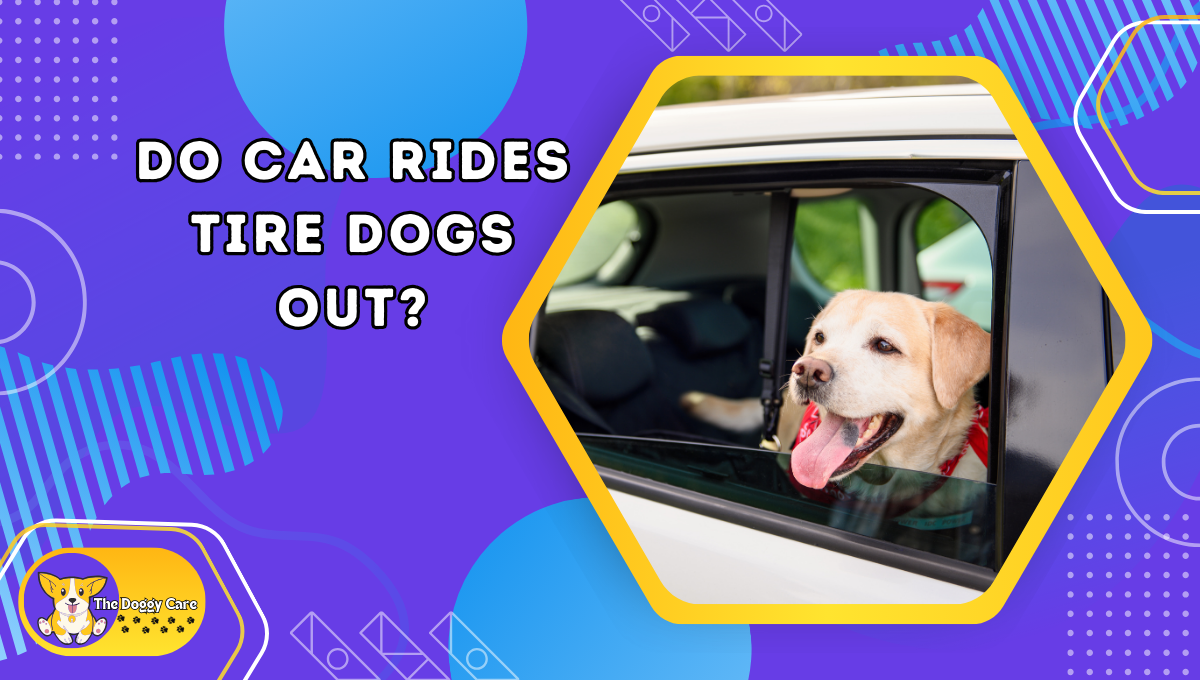Car rides can be an exciting adventure for dogs, but depending on various factors, they can also lead to fatigue. Understanding how car rides affect dogs is essential for ensuring their well-being and enjoyment.

Contents
How Dogs React to Car Rides
Dogs’ reactions to car rides vary greatly. Some dogs eagerly anticipate the adventure, showing excitement through wagging tails and eager behavior.
They may enjoy sticking their heads out of the window, taking in the scents and sights.
However, other dogs may feel anxious or fearful, displaying signs like panting, drooling, or trembling.
These reactions can stem from past negative experiences or discomfort with the car’s movement.
Understanding your dog’s individual temperament and providing positive reinforcement can help alleviate anxiety and make car rides a more enjoyable experience for them.
Gradual exposure and comforting cues from their owners can help dogs feel more relaxed and at ease during car rides.
Do Car Rides Tire Dogs Out?
Yes, car rides can tire dogs out, depending on various factors such as duration, frequency, and temperament.
While some dogs may find car rides exhilarating and energizing, others may become fatigued due to the excitement or stress of the experience.
Sedentary behavior during car rides can also contribute to feelings of tiredness in dogs, particularly during long journeys. It’s essential to monitor your dog’s behavior and energy levels after a car ride to ensure they receive the rest they need.
Physical Effects of Car Rides on Dogs
Car rides can have both physical and sedentary effects on dogs. While the excitement of the journey may involve physical activity, such as jumping in and out of the car, the actual ride itself is often relatively sedentary.
This lack of movement can lead to a decrease in energy levels and contribute to fatigue in some dogs.
Additionally, prolonged periods of sitting in one position may cause stiffness or discomfort, especially in older or less mobile dogs.
Providing breaks and opportunities for movement during car rides can help mitigate these physical effects and ensure your dog remains comfortable throughout the journey.
Mental Stimulation During Car Rides
Car rides offer dogs valuable mental stimulation as they are exposed to new sights, sounds, and smells. The ever-changing scenery provides an enriching experience, engaging their senses and curiosity.
Dogs may enjoy watching passing vehicles, observing people, or simply taking in the surroundings. This mental stimulation can help prevent boredom and provide an outlet for their instincts.
However, it’s essential to monitor your dog’s reaction to ensure they are not overwhelmed by the stimuli. Overall, car rides can offer dogs a stimulating and enjoyable experience that contributes to their overall mental well-being.
Factors Influencing the Impact of Car Rides
Several factors influence how car rides impact dogs. The duration of the ride plays a significant role, with longer journeys potentially leading to more fatigue.
The frequency of rides also matters, as frequent exposure may desensitize dogs and make them more comfortable.
Additionally, the dog’s comfort level in the car, including factors like temperature, seating arrangement, and restraints, can affect their experience.
Understanding these factors allows owners to tailor car rides to their dog’s needs, ensuring a positive and comfortable experience for their furry friend.

Signs That a Car Ride Has Tired Your Dog
Several signs indicate that a car ride has tired your dog. Behavioral indicators include decreased activity levels, such as reluctance to move or play, excessive yawning, or seeking out a quiet space to rest.
Physically, your dog may exhibit signs of fatigue such as droopy eyes, slumped posture, or even falling asleep shortly after the ride.
Recognizing these signs allows you to provide your dog with the necessary rest they need to recover from the journey.
Benefits of Car Rides for Dogs
Car rides offer numerous benefits for dogs beyond just transportation. They provide valuable mental stimulation by exposing dogs to new environments, sights, and smells, which can help prevent boredom and alleviate stress.
Additionally, car rides promote bonding between dogs and their owners, as they often accompany them on adventures.
Exposure to different settings and experiences during car rides can also help desensitize dogs to various stimuli, making them more adaptable and confident.
Overall, car rides contribute to a dog’s overall well-being by providing enrichment, stimulation, and quality time with their beloved human companions.
Tips for Making Car Rides Enjoyable
Gradual Exposure: Introduce your dog to car rides gradually, starting with short trips and gradually increasing the duration.
Positive Reinforcement: Use treats, praise, and toys to create positive associations with car rides.
Comfortable Restraints: Ensure your dog is safely secured in the car with a harness, crate, or seat belt to prevent injury and anxiety.
Frequent Breaks: Take regular breaks during long journeys to allow your dog to stretch, drink water, and relieve themselves.
Comfortable Environment: Make the car interior comfortable with familiar bedding and adequate ventilation to keep your dog relaxed.
Calming Techniques: Use calming aids such as calming sprays, music, or pheromone diffusers to help relax nervous dogs.

FAQs
Do all dogs get tired after car rides?
Not all dogs experience fatigue after car rides. Some may find them invigorating, while others may become tired due to the excitement or stress of the experience.
How can I tell if my dog enjoys car rides?
Watch for signs of excitement, such as wagging tails, eager behavior, and relaxed body language. Conversely, signs of anxiety or fear, such as panting, drooling, or trembling, may indicate that your dog does not enjoy car rides.
Can car rides help with dog anxiety?
For some dogs, gradual exposure to car rides combined with positive reinforcement can help alleviate anxiety. However, for others, car rides may exacerbate anxiety, so it’s essential to monitor your dog’s reactions and seek professional help if needed.
Should I let my dog sleep during car rides?
Allowing your dog to sleep during car rides is perfectly normal and can be a sign of relaxation. Ensure that your dog is safely secured in the car to prevent injury in the event of sudden stops or accidents.
Are there any safety precautions I should take for car rides with my dog?
Yes, always use appropriate restraints, such as a harness or crate, to keep your dog secure during car rides. Avoid leaving your dog unattended in the car, especially in hot weather, and provide plenty of water and breaks during long trips.
Conclusion
While car rides can tire dogs out, they also offer valuable mental stimulation and enrichment. By understanding your dog’s individual needs and preferences, you can make car rides a positive and enjoyable experience for both of you.



























